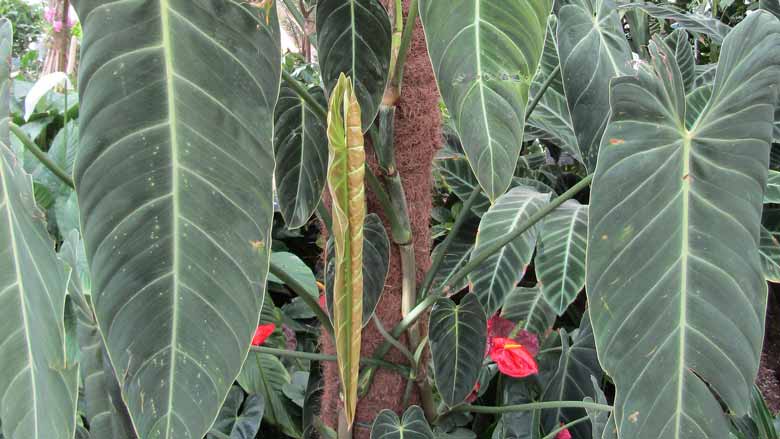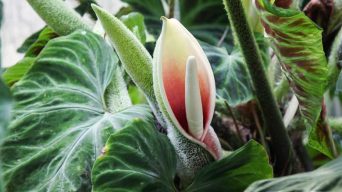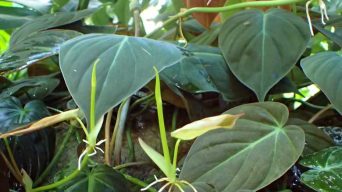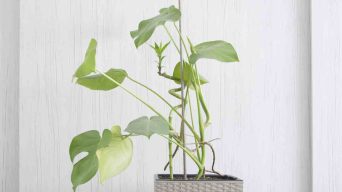If you’re interested in growing Philodendron melanochrysum, you’ll be rewarded with a stunning houseplant.
Taking care of a Philodendron melanochrysum is similar to taking care of other philodendron plants.
While it’s not difficult to care for this tropical plant, there are a few things to keep in mind to ensure it thrives.
Here you’ll find everything you need to know about Philodendron melanochrysum care!
Overview
Philodendron melanochrysum, also known as Black Gold Philodendron, is a species of flowering plant in the family Araceae, native to South America.
It is an evergreen vine that can grow to 3 m (9.8 ft) in length, with heart-shaped leaves 20-30 cm (7.9-11.8 in) long and 15-20 cm (5.9-7.9 in) wide.
The leaves are dark green with yellow veins.
The flowers are small and white, and their blooming typically occurs in the spring or summer.
This plant is commonly used as an ornamental houseplant or outdoor landscape plant in warm climates.
How To Care for Philodendron Melanochrysum
Philodendron melanochrysum care is similar to caring for other philodendron plants.
They are generally low-maintenance and easy-to-care-for plants.
Here you’ll find everything you need to know about Philodendron melanochrysum care, including tips on watering, light, humidity, temperature, and fertilizing.
Sun Exposure & Light Requirements
Philodendron melanochrysum is a tropical plant that thrives in warm, humid environments.
It grows under the canopy of rainforests in its natural habitat, where it receives dappled sunlight.
When grown as a houseplant, Philodendron melanochrysum should be given bright, indirect light.
It will tolerate lower light levels but may become leggy and have fewer leaves.
Excessive exposure to direct sunlight can lead to leaf scorching in Philodendron plants. If you observe yellow or brown leaf discoloration, consider relocating your plant to a more shaded area.
Philodendron melanochrysum can be planted in partial shade to full sun when grown outdoors. If you live in a hot climate, it’s best to give your plant some afternoon shade.
When grown indoors, Philodendron melanochrysum can be placed in a bright room with indirect sunlight.
An east- or west-facing window is ideal. This will provide the right amount of light without scorching the leaves.
South-facing windows will also work but may require you to move your plant further away from the window to prevent leaf scorch.
North-facing windows usually don’t provide enough light for this plant.
If you can’t provide bright, indirect light, you can grow Philodendron melanochrysum under fluorescent lights.
Place your plant about 12 inches (30 cm) beneath the light source and leave it on for 14 to 16 hours per day.
Watering Requirements
The Philodendron melanochrysum plant does not like to be waterlogged, and you should allow the top couple of inches of soil to dry out between watering.
They are much more tolerant of being underwatered than overwatered – if in doubt, err on the side of too little water rather than too much!
You should water your Philodendron plant around once a week or when the soil has dried out.
When you water your Philodendron melanochrysum, make sure you do so thoroughly.
Allow the water to run through the drainage holes in the bottom of the pot, and empty any drip tray after a few minutes.
Don’t let the plant sit in water, as this can lead to root rot.
Use lukewarm water rather than cold water, as this will help to prevent shocking the roots.
During winter, your Philodendron melanochrysum will need less water than in summer.
Allow the soil to dry out almost completely before watering, and reduce watering frequency to around once every two weeks.
Soil Requirements
Philodendron melanochrysum will grow well in a wide range of soils as long as it is well-drained.
A soil mix for Philodendron should be light and airy to allow good drainage.
It is essential not to let the roots sit in water, as this can cause root rot.
An aroid mix or African violet mix is a good option for Philodendron melanochrysum.
You can also make your own mix by combining potting soil, peat moss, perlite, and orchid bark in equal parts.
Temperature and Humidity
The Philodendron melanochrysum plant grows best in warm, humid conditions with temperatures of at least 18°C (65°F).
In its natural habitat, it experiences regular rainfall and high humidity.
If you live in an area with a dry climate, you will need to provide additional humidity for your plant.
This can be done by misting the leaves regularly or placing the pot on a pebble tray.
Regarding temperature, the Philodendron melanochrysum can tolerate a range of 18-24°C (65-75°F).
However, it will grow best between 21-23°C (70-73°F).
When the temperature drops to 18°C (65°F) or lower, it could lead to the yellowing of Philodendron leaves.
Keeping your Philodendron melanochrysum plant away from drafts, heaters, and air conditioners is best.
Fertilizing
Philodendron melanochrysum should be fertilized regularly during the growing season (spring and summer) with a balanced fertilizer.
Be sure to dilute the fertilizer to half-strength or less to avoid burning the plant roots.
You can also use a slow-release fertilizer lasting 3-4 months.
Stop fertilizing in the fall and winter when the plant is dormant.
Potting and Repotting
Just like many other houseplants, Philodendron melanochrysum benefits from being repotted every once in a while.
This gives the plant a fresh potting mix to grow in and provides an opportunity to check on the health of the roots.
The best time to repot your Philo melanochrysum is in the spring before the plant begins its active growth period.
Use a pot slightly larger than the current one, and add fresh potting mix.
A clay pot with drainage holes is ideal.
When you repot Philodendron melanochrysum, be sure to handle the roots carefully.
These plants are susceptible to root damage, and it can take a long time to recover.
Gently loosen the root ball and place it in the new pot.
Fill around the root ball with fresh potting mix, and wait a week or two before watering.
This will give the plant time to adjust to its new pot and soil.
Pruning
Philodendron melanochrysum can be pruned to remove damaged or unhealthy leaves and shape the plant.
To prune, use clean, sharp shears or a knife and cut just above a node (the point on the stem where a leaf is attached).
New growth will emerge from nodes, so be sure not to remove too many leaves at once, or you’ll stunt the plant’s growth.
To keep your Philodendron melanochrysum looking its best, prune it regularly.
You can do this by cutting back the stems that have become too long. You can also remove any yellow or brown leaves.
If you want to encourage your plant to grow fuller, you can cut the stem in half.
Remove any dead or dying leaves from your plant as soon as you notice them.
This will help to prevent the spread of disease.
Pests
Philodendron melanochrysum plants are not susceptible to many pests, but mealybugs and aphids can be a problem.
Mealybugs are small, white, fuzzy insects that suck the sap from plants.
Aphids are small, green, or black insects that also suck the sap from plants.
Both of these pests can be controlled with insecticidal soap or neem oil.
To get rid of mealybugs, spray the plant with insecticidal soap or neem oil.
Be sure to get the undersides of the leaves where they like to hide. Y
ou may need to treat the plant every week or two until the mealybugs are gone.
Aphids can be controlled in the same way as mealybugs.
However, you may also want to introduce ladybugs to your garden.
Ladybugs are aphids’ predators and will help keep their population under control.
Diseases
Philodendron melanochrysum plants are not susceptible to many diseases, but they can be affected by root rot and powdery mildew.
Root rot is caused by too much water and can be fatal to the plant.
Powdery mildew is a white, powdery fungus that grows on the leaves of plants.
To prevent root rot, plant Philodendron melanochrysum in well-draining soil.
If the philodendron plant does get root rot, you can try to save it by replanting it in fresh, well-draining soil.
To prevent powdery mildew, water the plant in the morning so the leaves have time to dry before nightfall.
If the plant does get powdery mildew, you need to cut off all the affected leaves.
You can also try spraying the plant with a fungicide.
How to Care for Philodendron Melanochrysum in Winter
When winter comes, Philodendron melanochrysum care changes a bit.
This plant is native to tropical regions and does not tolerate cold weather well.
If you live in an area that gets cold winters, you will need to take measures to protect your plant.
The following tips will help you care for Philodendron melanochrysum in winter:
- Move the plant indoors or into a greenhouse. This is the most crucial step in winter care. Philodendron melanochrysum will not survive if it is exposed to freezing temperatures.
- Water the plant less often. The soil should be allowed to dry out somewhat between watering.
- Move the plant to a brighter location. Philodendron melanochrysum needs bright, indirect light to thrive. A south-facing window is a good option.
- Don’t fertilize the plant during winter. This is a time of dormancy for Philodendron melanochrysum, and it doesn’t need extra nutrients.
- Check the plant regularly for pests. Philodendron melanochrysum is susceptible to mealybugs, scale, and other common houseplant pests.
- Keep an eye on the temperature. Philodendron melanochrysum does not like cold drafts. Make sure the room it is in is not too cold.
- Humidity is also essential for this plant. Philodendron melanochrysum prefers high humidity. If the air in your home is dry, you can use a humidifier or pebble tray to raise the humidity around the plant.
With a bit of extra care, you can successfully overwinter Philodendron melanochrysum.
This tropical plant makes a beautiful addition to any indoor space.
By following the above tips, you can keep your plant healthy and happy all winter long.
How To Propagate Philodendron Melanochrysum
Philodendron melanochrysum is a beautiful and popular Philodendron species that is relatively easy to care for. It is also fairly easy to propagate.
Here we will go over everything you need to know to propagate your own Philodendron melanochrysum successfully.
Philodendron melanochrysum can be propagated by rooting stem cuttings in water or soil.
They can also be propagated by seeds, although this is a more difficult and less common method.
Stem Cuttings
This is the most common and easiest method of propagation.
To propagate stem cuttings in water:
- Cut a stem that is at least 6 inches long from an existing Philodendron melanochrysum plant. Cut just below a leaf node (the point on the stem where leaves are growing).
- Remove any leaves from the bottom half of the cutting.
- Place the cutting in a glass or jar of water.
- Place the glass or jar in a warm, bright spot out of direct sunlight.
- Change the water every few days to keep it fresh.
- Roots should start to form within 2-4 weeks. Once roots have formed, you can transplant the cutting into a pot filled with potting mix.
It is best to use a well-draining potting mix and a pot with drainage holes when planting in soil.
To propagate stem cuttings in soil:
- Cut a stem that is at least 6 inches long from an existing Philodendron melanochrysum plant. Cut just below a leaf node (the point on the stem where leaves are growing).
- Remove any leaves from the bottom half of the cutting.
- Dip the cut end of the stem in rooting hormone powder.
- Place the cutting in a pot filled with moist potting mix.
- Firm the potting mix around the base of the cutting.
- Place the pot in a warm, bright spot out of direct sunlight.
- Keep the potting mix moist but not wet.
- Roots should start to form within 2-4 weeks. Once roots have formed, you can transplant the cutting into a larger pot.
Seeds
Although this is a more difficult method, Philodendron melanochrysum can also be propagated by seeds.
To propagate by seeds:
- Fill a seed tray with moistened potting mix.
- Sow the seeds on the surface of the potting mix, and then lightly cover them with additional soil mix.
- Place the tray in a warm, humid location out of direct sunlight.
- Keep the soil moist but not soggy, and wait for the seeds to germinate.
- Once the seedlings have sprouted, thin them out so that only the healthiest plants remain.
- Transplant the seedlings into individual pots once they are large enough to handle.
Seedlings are notoriously delicate, so extra care must be taken when transplanting them.
It is best to wait until the seedlings are at least 6 inches tall before attempting to transplant them.
Place the pots in a warm, bright location out of direct sunlight.
Extra care must be taken when watering Philodendron melanochrysum seedlings, as they are susceptible to root rot. Allow the potting mix to dry out slightly between waterings.
After a few months, the seedlings should be large enough to transplant into larger pots.
Final Thoughts
Growing Philodendron melanochrysum is easy as long as you provide it with the right conditions.
This includes bright indirect light, moist but well-drained soil, and humid air.
With proper care, your Philodendron melanochrysum will thrive and produce beautiful leaves that will impress anyone who sees them.







